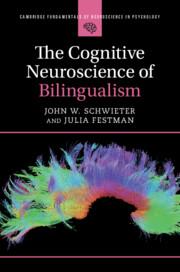126 results
The role of prosodic sensitivity and executive functions in L2 reading: The moderated mediation effect – ERRATUM
-
- Journal:
- Bilingualism: Language and Cognition , First View
- Published online by Cambridge University Press:
- 02 April 2024, p. 1
-
- Article
-
- You have access
- Open access
- HTML
- Export citation
The role of prosodic sensitivity and executive functions in L2 reading: The moderated mediation effect
-
- Journal:
- Bilingualism: Language and Cognition , First View
- Published online by Cambridge University Press:
- 04 March 2024, pp. 1-12
-
- Article
-
- You have access
- Open access
- HTML
- Export citation
Neural correlates of compound head position in language control: Evidence from simultaneous production and comprehension
-
- Journal:
- Bilingualism: Language and Cognition , First View
- Published online by Cambridge University Press:
- 10 January 2024, pp. 1-13
-
- Article
- Export citation
Chapter One - Theories and Methods in the Cognitive Neuroscience of Bilingualism
-
- Book:
- The Cognitive Neuroscience of Bilingualism
- Published online:
- 01 October 2023
- Print publication:
- 19 October 2023, pp 1-19
-
- Chapter
- Export citation
References
-
- Book:
- The Cognitive Neuroscience of Bilingualism
- Published online:
- 01 October 2023
- Print publication:
- 19 October 2023, pp 182-245
-
- Chapter
- Export citation
Copyright page
-
- Book:
- The Cognitive Neuroscience of Bilingualism
- Published online:
- 01 October 2023
- Print publication:
- 19 October 2023, pp iv-iv
-
- Chapter
- Export citation
Tables
-
- Book:
- The Cognitive Neuroscience of Bilingualism
- Published online:
- 01 October 2023
- Print publication:
- 19 October 2023, pp ix-ix
-
- Chapter
- Export citation
Chapter Six - Bilingual Lexical and Conceptual Memory
-
- Book:
- The Cognitive Neuroscience of Bilingualism
- Published online:
- 01 October 2023
- Print publication:
- 19 October 2023, pp 126-150
-
- Chapter
- Export citation
Contents
-
- Book:
- The Cognitive Neuroscience of Bilingualism
- Published online:
- 01 October 2023
- Print publication:
- 19 October 2023, pp v-vii
-
- Chapter
- Export citation
Chapter Seven - Cognitive and Neurocognitive Effects of Bilingualism
-
- Book:
- The Cognitive Neuroscience of Bilingualism
- Published online:
- 01 October 2023
- Print publication:
- 19 October 2023, pp 151-172
-
- Chapter
- Export citation
Index
-
- Book:
- The Cognitive Neuroscience of Bilingualism
- Published online:
- 01 October 2023
- Print publication:
- 19 October 2023, pp 246-249
-
- Chapter
- Export citation
Chapter Four - Aphasia and the Bilingual Brain
-
- Book:
- The Cognitive Neuroscience of Bilingualism
- Published online:
- 01 October 2023
- Print publication:
- 19 October 2023, pp 75-98
-
- Chapter
- Export citation
Chapter Eight - Conclusion
-
- Book:
- The Cognitive Neuroscience of Bilingualism
- Published online:
- 01 October 2023
- Print publication:
- 19 October 2023, pp 173-181
-
- Chapter
- Export citation
Chapter Three - Bilingualism, Language Development, and Brain Plasticity
-
- Book:
- The Cognitive Neuroscience of Bilingualism
- Published online:
- 01 October 2023
- Print publication:
- 19 October 2023, pp 44-74
-
- Chapter
- Export citation
Chapter Two - Neural Representations and Language Processing in the Bilingual Brain
-
- Book:
- The Cognitive Neuroscience of Bilingualism
- Published online:
- 01 October 2023
- Print publication:
- 19 October 2023, pp 20-43
-
- Chapter
- Export citation
Figures
-
- Book:
- The Cognitive Neuroscience of Bilingualism
- Published online:
- 01 October 2023
- Print publication:
- 19 October 2023, pp viii-viii
-
- Chapter
- Export citation
Acknowledgments
-
- Book:
- The Cognitive Neuroscience of Bilingualism
- Published online:
- 01 October 2023
- Print publication:
- 19 October 2023, pp x-x
-
- Chapter
- Export citation
Chapter Five - Cross-Linguistic Effects of Bilingualism
-
- Book:
- The Cognitive Neuroscience of Bilingualism
- Published online:
- 01 October 2023
- Print publication:
- 19 October 2023, pp 99-125
-
- Chapter
- Export citation

The Cognitive Neuroscience of Bilingualism
-
- Published online:
- 01 October 2023
- Print publication:
- 19 October 2023
3 - Bilingualism Across the Life Span
-
- Book:
- Bilingualism Matters
- Published online:
- 29 June 2023
- Print publication:
- 20 July 2023, pp 39-56
-
- Chapter
- Export citation



